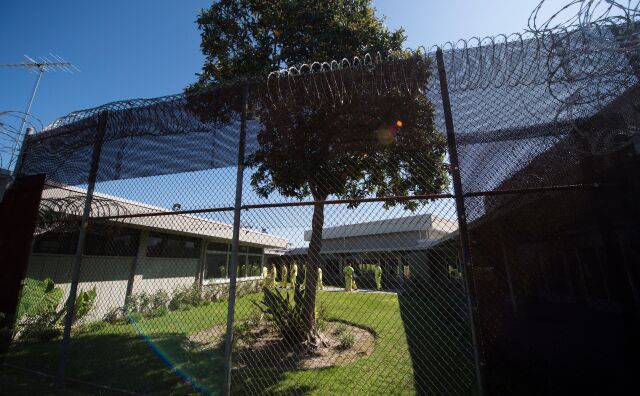Exactly one year ago, the Los Angeles County Board of Supervisors received a detailed plan to close the beleaguered Men’s Central Jail within 18 to 24 months. Activists rallied Wednesday to press the county to stick to that timeline, while the county said it can’t project how long it will take.
‘It’s very simple,” Mark-Anthony Clayton-Johnson, with the activist group Dignity and Power Now, told the gathering outside L.A.’s Hall of Justice. “We’ve talked about it. We’ve shown you how to do it. And now’s the time to shut it down.”
The JusticeLA Coalition is calling for the closure of the jail by March 2023. It’s also demanding that the county allocate $237 million to create 3,600 new mental health beds, and fully fund a pretrial services agency in the next six months.
Last March, the Board of Supervisors received a 145-page proposal prepared by a workgroup led by the County Office of Diversion and Reentry and the Sheriff’s Department, in partnership with community groups and service providers.
The proposal laid out a three-pronged strategy for shutting down the nearly 60-year-old, "unsafe, crowded and crumbling" jail:
- Redistribute the MCJ population to other jails;
- Invest “significantly” in beds and services within the community;
- Divert some 4,500 people with mental health issues out of jail (roughly the size of that population at MCJ).
-
It's gonna be Yankees v the Boys in Blue
-
Nonprofit's launching fundraiser to keep it afloat
-
USC study documents what residents want from trees
In June, the board voted 4-1 to set up a team to close Men’s Central Jail.
There Has Been Some Progress
There has been progress since then, according to Michelle Parris at the Vera Institute of Justice, who also worked on the plan to shut the jail down. Last August, the Board approved a $187 million spending package to advance the Care First, Jails Last initiative. And earlier this month, the Board committed to create a new department that would centralize programs such as those offering prevention, pretrial and reentry services for adults.
“That's super important, because 6,000 people are in jail pretrial right now,” Parris said, “people who are just there because they can't afford to pay bail to get out of jail.”
But now, Parris said, there needs to be funding allocated to pathways out of jail. “We’re entering the budget cycle,” she said. “That's what we're here today for, to really try to get them in the driver's seat.”
L.A. County said in a statement that while it’s committed to closing Men’s Central “as swiftly as possible … it is difficult to project an exact timeline.” It said the 24-month timeline assumed “perfect implementation and coordination among all stakeholders.” The statement pointed to a September 2021 study that said the effort could take longer than two years.
“Despite the extensive efforts underway, depopulating and closing MCJ is not a short-term undertaking,” the statement said, noting that the project includes “building a new system of housing and supportive services that prioritizes Care First, Jails Last as well as public safety.”
‘We Don’t Want To Be Here 10 Years Later’
The overall jail census has been reduced by 12% since last September, according to county officials.

But too many people continue to suffer inside the jail, said James Nelson of Dignity and Power Now. He was incarcerated at Men’s Central in 1984, and said it was dirty and dangerous then, and it still is now.
“It is a traumatic experience being in there,” Nelson said. “County officials have already agreed that it’s not livable.”
There are also alarming racial disparities in the makeup of the jail population. Black residents make up only 8% of L.A. County’s population, but nearly 30% of the people in L.A.’s jails, according to an analysis of County Sheriff’s Department data by the Vera Institute of Justice.
The county has talked about closing the jail for at least a decade, said Dolores Canales of the Bail Project.
“We don’t want to be here 10 years later. We don’t want to be here one year later,” she said. “The time is now, and the time is today.”
Robert Garrova contributed reporting for this story.










